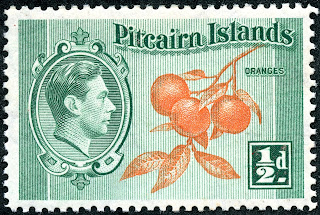1940 Scott 5 3p dark blue & yellow green
"Map of Pitcairn and Pacific Ocean"
Into the Deep Blue
Many school boy stamp collectors of my era would revel in the story of "Mutiny on the Bounty" and Pitcairn Island- and not a few adults!
Unfortunately, "Big Blue", the Scott International 1840-1940 album, left out the October 15, 1940 initial Pitcairn Islands issue commemorating the event, and hence I have never published a post about Pitcairn Islands. (Stamp spaces for the issue do appear in Scott Part II 1940-49 album.)
Joe Lil, one of the longtime collectors using Big Blue, wondered about the vacancy. So, this post is for you Joe!
1940 Scott 6 6p slate green & deep brown
"H.M. Armed Vessel "Bounty""
Since the Pitcairn Islands was a British colony under the British High Commissioner of New Zealand, it is not surprising that a bi-color pictorial issue was produced. Most colonies issued their sets in 1938, but Pitcairn Islands, with a grand total of 177 people (1943), issued eight stamps on 10/15/40, and two additional stamps on 9/1/51. BTW, a more recent population count (1984) found 57 people there.
One might argue that 177 people do not need their own stamp issue, but we are talking about a very romantic high seas story indeed, and no doubt 99.9% of the stamps were sold to stamp collectors for revenue. And many other British colonies, although having a much larger population, had very few literate mail writing citizens for their issues - so, really, not that unusual.
1940 Scott 4 2p dark brown & bright green
"William Bligh and H.M. Armed Vessel "Bounty""
The issue was engraved (my favorite!), and produced by Bradbury Wilkinson & Co Ltd. (1940 1p, 3p, 2sh6p; 1951 4p, 8p); and Waterlow ( 1940 1/2p, 1 1/2p, 2p, 6p, 1sh).
CV ranges from <$1 to $10+. The 1951 stamps (4p, 8p) are at the higher end.
Close-up: "Wm Bligh"
Pitcairn Island was not inhabited until 1790, when then it was occupied by the mutineers of H.M.S.
"Bounty".
"Bounty".
For more on Captain Bligh, see here. He and his loyal men were set adrift in Bounty's launch, and they finally reached Timor alive, some 4,160 miles away. !!
The settlement by the "Bounty" mutineers was not discovered until 1808 when an American whaler (Topaz) called there. (Can you imagine - 18 years!)
.
.
Overcrowding led to resettlement in 1831 (Tahiti), and 1856 (Norfolk Island), but a number of families went back to Pitcairn in 1859 and 1864,
1940 Scott 7 1sh slate & violet
"Fletcher Christian and View of Pitcairn Island"
For those interested in the philatelic history, there is the Pitcairn Island Study Group, and the Pitcairn-Norfolk Philatelic Society.
1940 Scott 2 1p red lilac & rose violet
"Fletcher Christian with Crew and View of Pitcairn Island"
In 1920, regular mail service was introduced. There were no stamps available, but the letters were allowed free postage along as they carried a cachet indicating their origin. The Stanley Gibbons catalogue (Commonwealth & British Empire Stamps 1840-1970)) carries illustrations of these cachets, which state: "Posted in Pitcairn. No Stamps available".
Close-up: "Fletcher Christian with Crew"
Note the Breadfruit Tree
For more on Fletcher Christian see this.
Fletcher Christian and the mutineers seize HMS Bounty on 28 April 1789.
Engraving by Hablot Knight Browne, 1841
1940 Scott 8 2sh6p dark brown & bright green
"Fletcher Christian and Crew and Coast of Pitcairn"
Fletcher Christian, with eight mutineers, six Tahitian men and eleven Tahitian women, settled on Pitcairn island, and the "Bounty" was burned. Conflict ensued between and among the mutineers and the Tahitian men over the next several years, and Fletcher Christian was subsequently murdered along with others.
1940 Scott 3 1 1/2p rose carmine & black
"John Adams and His House"
John Adams was the last surviving mutineer.
1951 Scott 5A 4p dark blue green & black
"Bounty Bible"
The Bounty Bible is an important artifact, now residing, after years in Connecticut, in a museum on Pitcairn. As the tale goes, there were significant disputes on Pitcairn Island over land, women and so forth by the men there - with murders back and forth - until there were only two men left.
One of the surviving men was John Adams. He amended his brutish ways, and took up reading the Bounty Bible. A "Christian civilized" order, guided by the Bounty Bible, was then adopted.
1940 Scott 1 1/2p blue green & orange
"Cluster of Oranges"
What did people eat and sell in the smallest and most remote place in the world?
"Adapting themselves to the needs of their seafaring visitors the islanders became skilled market gardeners, producing potatoes, yams, coconuts, bananas, oranges, limes and chickens, for which they accepted in return clothing, tools and money."
1951 Scott 6A 8p lilac rose & green
"Pitcairn School, 1949"
The 1951 issue stamp shows the development of a school, established in 1949. Today, after age 13, education is continued at a boarding school in New Zealand.
I should mention that I do have "used" copies of Pitcairn stamps (pictured below). No doubt virtually all of the "used" stamps are philatelic in origin. But to think that the stamp was once on Pitcairn island: that is still thrilling.
1940 Scott 3 1 1/2p rose carmine & black
"John Adams and His House"
Cancelled "Pitcairn Island Post Office"
Out of the Blue
I think we all have a secret desire to move to Pitcairn Island - but this will have to do. ;-)
Note: Quote is from Wikipedia search. The Engraving print is from the public domain, and used here for educational purposes.
Comments appreciated!














No comments:
Post a Comment